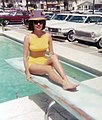1960s in fashion
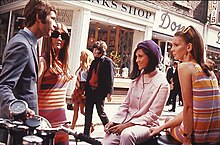

Fashion of the 1960sfeatured a number of diverse trends, as part of a decade that broke many fashion traditions, adopted new cultures, and launched a new age of social movements. Around the middle of the decade, fashions arising from small pockets of young people in a few urban centers received large amounts of media publicity, and began to heavily influence both thehaute coutureof elite designers and the mass-market manufacturers. Examples include themini skirt,culottes,go-go boots,and more experimental fashions, less often seen on the street, such as curvedPVCdresses and otherPVC clothes.
Mary Quantpopularized themini skirt,andJackie Kennedyintroduced thepillbox hat;[1]both became extremely popular. False eyelashes were worn by women throughout the 1960s. Hairstyles were a variety of lengths and styles.[2]Psychedelic prints, neon colors, and mismatched patterns were in style.[3]

In the early-to-mid 1960s, London "Modernists" known asModsinfluenced male fashion in Britain.[4]Designers were producing clothing more suitable for young adults, leading to an increase in interest and sales.[5]In the late 1960s, thehippiemovement also exerted a strong influence on women's clothing styles, includingbell-bottom jeans,tie-dyeandbatikfabrics, as well aspaisleyprints.
Women's fashion[edit]
Early 1960s (1960–1962)[edit]
High fashion[edit]
Fashions in the early years of the decade reflected the elegance of the First Lady,Jacqueline Kennedy.In addition to tailored skirts, women worestiletto heelshoes and suits with short boxy jackets, and oversized buttons. Simple, geometric dresses, known as shifts, were also in style. For evening wear, full-skirted evening dresses were worn; these often had low necklines or boat-necklines and close-fitting waists. For casual wear,capri trouserswere the fashion for women and girls.[citation needed]
The rise of trousers for women[edit]

The 1960s were an age of fashion innovation for women. The early 1960s gave birth todrainpipe jeansandcapri pants,a style popularized byAudrey Hepburn.[6]Casual dress became more unisex and often consisted of plaid button down shirts worn with slim blue jeans, comfortable slacks, or skirts. Traditionally, trousers had been viewed by western society as masculine, but by the early 1960s, it had become acceptable for women to wear them every day. These includedLevi Straussjeans, previously considered blue collar wear, and "stretch"drainpipe jeanswithelastane.[7]Women's trousers came in a variety of styles: narrow, wide, below the knee, above the ankle, and eventually mid thigh. Mid-thigh cut trousers, also known as shorts, evolved around 1969. By adapting men's style and wearing trousers, women voiced their equality to men.[8]
Mid 1960s (1963–1966)[edit]
Bikini[edit]

The modernbikini,named after the nuclear test site onBikini Atoll,was invented in France byLouis Réardin 1946 but struggled to gain acceptance in the mass-market during the 1950s, especially in America. In 1963, rather large versions of bikinis featured in the surprise hit teen filmBeach Party,which led a wave of films that made the bikini a pop-culture symbol.
The firstSports Illustrated Swimsuit Issue,in 1964, featuredBabette Marchin a white bikini on the cover.[9]This has been credited with making the bikini a legitimate piece of clothing.[10]
Monokini[edit]
Themonokini,also known as a "toplessbikini"or" unikini ",[11][12]was designed byRudi Gernreichin 1964, consisting of only a brief, close-fitting bottom and two thin straps;[13]it was the first women'stopless swimsuit.[14][15]Gernreich's revolutionary and controversial design included a bottom that "extended from the midriff to the upper thigh"[16]and was "held up by shoestring laces that make a halter around the neck."[17]Some credit Gernreich's design with initiating,[15]or describe it as a symbol of, thesexual revolution.[18]
Space Age fashions[edit]

Space age fashion first appeared in the late 1950s,[19][20]and developed further in the 1960s. It was heavily influenced by theSpace Raceof theCold War,in addition to popularscience fictionpaperbacks,films and television series such asStar Trek: The Original Series,Dan Dare,orLost In Space.Designers often emphasized the energy and technology advancements of the Cold War era in their work.[21]
The space age look was defined by boxy shapes, thigh length hemlines and bold accessories. Synthetic material was also popular with space age fashion designers. After the Second World War, fabrics like nylon, corfam, orlon, terylene, lurex and spandex were promoted as cheap, easy to dry, and wrinkle-free. The synthetic fabrics of the 1960s allowed space age fashion designers such as the latePierre Cardinto design garments with bold shapes and a plastic texture.[22]Non-cloth material, such aspolyester,lucite,andPVC,became popular in clothing and accessories as well. For daytime outerwear, short plastic raincoats, colourfulswing coats,bubble dresses,helmet-like hats, and dyed fake-furs were popular for young women.[23]Colors associated with Space Age fashions, especially in 1965 and '66, were dominated by metallic silver[24][25]and the stark whites ofAndré Courrèges.The futuristic-looking geometry of theOp Artof such artists asBridget RileyandVictor Vasarelyinfluenced prints,[26][27]as did geometric art from earlier in the century like that ofPiet Mondrian,inspiration forYves Saint Laurent's popularMondrian shift dressesof 1965. Fluorescent colors (also known as day-glo or neon) and even light-up dresses like those shown byDiana Dewin 1967 were also seen. In 1966, theNehru jacketarrived on the fashion scene, and was worn by both sexes. Suits were very diverse in color but were, for the first time ever,[citation needed]fitted and very slim. Waistlines for women were left unmarked and hemlines were getting shorter and shorter.
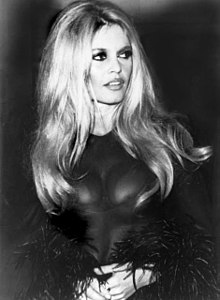
Footwear for women included low-heeled sandals and kitten-heeled pumps, as well as trendy whitego-go bootsand shoes of transparent plastic.[28]Shoes, boots, and handbags were often made ofpatent leatherorvinyl.[29]The Beatles wore elastic-sided boots similar toWinkle-pickerswith pointed toes andCuban heels.These were known as "Beatle boots" and were widely copied by young men in Britain.
The French designerAndré Courrègeswas particularly influential in the development of space age fashion. The "space look" he introduced in the spring of 1964 included trouser suits, goggles, box-shaped dresses with high skirts, and go-go boots. Go-go boots eventually became a staple of go-go girl fashion in the 1960s.[30]The boots were defined by their fluorescent colors, shiny material, and sequins.[31]
Other influential space age designers included Pierre Cardin,Paco Rabanne,Rudi Gernreich,[32]Emanuel Ungaro,Jean-Marie Armand,[33]Michèle Rosier,andDiana Dew,though even designers likeYves Saint Laurent[34][35][36][37]showed the look during its peak of influence from 1963 to 1967.[38][39]Italian-bornPierre Cardin[40]was best known for his helmets, short tunics, and goggles.[40]However, Paco Rabanne has been credited as the one who revolutionized the Space Age fashion.[41]Rabanne was known for his 1966 "12 Unwearable Dresses in Contemporary Materials" collection,[21]made of chain mail, aluminum, and plastic.[42]Rabanne would even design the iconic green dress, as well as the other costumes,Jane Fondawore in the 1968 science fiction filmBarbarella.[43][44]People Magazine journalist Hedy Philips described Rabanne's Space Age fashion as "turning the fashion world upside down."[45]
A timeless fashion piece: miniskirt[edit]

The definition of aminiskirtis a skirt with a hemline around 6, 7 inches above the knees. Early references to the miniskirt from the Wyoming newspaperThe Billings Gazette,described the miniskirt as a controversial item that was produced in Mexico City.[citation needed]During the 1950s, the miniskirt began appearing inscience fiction filmslikeFlight to MarsandForbidden Planet.[46]
Mary QuantandAndre Courregesboth contributed to the invention of the miniskirt during the 1960s.Mary Quant,A British designer, was one of the pioneers of the miniskirt during 1960. She named the skirt after her favorite car, the Mini Cooper. Quant introduced her design in the mid-1960s at her London boutique, Bazaar. She has said: "We wanted to increase the availability of fun for everyone. We felt that expensive things were almost immoral and the New Look was totally irrelevant to us." Miniskirts became popular in London and Paris and the term "Chelsea Look" was coined.[47]
Andre Courregeswas a French fashion designer who also began experimenting with hemlines in the early 1960s. He started to show space-age dresses that hit above the knee in late 1964. His designs were more structured and sophisticated than Quant's design.[citation needed]This made the miniskirt more acceptable to the French public. His clothes represented a couture version of the "Youthquake"street style and heralded the arrival of the" moon girl "look.[48]
As teen culture became stronger, the term "Youthquake"came to mean the power of young people. This was unprecedented before the 1960s. BeforeWorld War II,teenagers dressed and acted like their parents. Many settled down and began raising families when they were young, normally right after high school. They were often expected to work and assist their families financially. Therefore, youth culture begins to develop only after World War II, when the advancement of many technologies and stricter child labor laws became mainstream. Teenagers during this period had more time to enjoy their youth, and the freedom to create their own culture separate from their parents. Teens soon began establishing their own identities and communities, with their own views and ideas, breaking away from the traditions of their parents.[49]The fabulous "little girl" look was introduced to USA—styling with Bobbie Brooks, bows, patterned knee socks and mini skirts. The miniskirt and the "little girl" look that accompanied it reflect a revolutionary shift in the way people dress. Instead of younger generations dressing like adults, they became inspired by childlike dress.[50]
Second-wave feminismmade the miniskirt popular. Women had entered the professional workforce in larger numbers during World War II and many women soon found they craved a career and life outside the home.[51]They wanted the same choices, freedoms, and opportunities that were offered to men.[52]
During the mid-1960s, Mod girls wore very shortminiskirts,tall, brightly coloredgo-go boots,monochromatic geometric print patterns such ashoundstooth,and tight fitted, sleeveless tunics. Flared trousers and bell bottoms appeared in 1964 as an alternative tocapri pants,and led the way to the hippie period introduced in the 1960s. Bell bottoms were usually worn with chiffon blouses, polo-necked ribbed sweaters or tops that bared the midriff. These were made in a variety of materials including heavy denims, silks, and even elasticated fabrics.[53]Variations ofpolyesterwere worn along with acrylics.[4]A popular look for women was the suede mini-skirt worn with a French polo-neck top, square-toed boots, andNewsboy caporberet.This style was also popular in the early 2000s.
Women were inspired by the top models of those days, such asTwiggy,Jean Shrimpton,Colleen Corby,Penelope Tree,Edie SedgwickandVeruschka.Velvet mini dresses with lace-collars and matching cuffs, wide tent dresses andculottespushed aside the geometric shift. False eyelashes were in vogue, as was pale lipstick. Hemlines kept rising, and by 1968 they had reached well above mid-thigh. These were known as "micro-minis". This was when the "angel dress" first made its appearance on the fashion scene. A micro-mini dress with a flared skirt and long, wide trumpet sleeves, it was usually worn with patterned tights, and was often made of crocheted lace, velvet, chiffon or sometimes cotton with apsychedelicprint. The cowled-neck "monk dress" was another religion-inspired alternative; the cowl could be pulled up to be worn over the head. For evening wear, skimpy chiffon baby-doll dresses with spaghetti-straps were popular, as well as the "cocktail dress", which was a close-fitting sheath, usually covered in lace with matching long sleeves.[54]Feather boaswere occasionally worn. Famous celebrities associated with marketing the miniskirt included:Twiggy;modelJean Shrimpton,who attended an event in the Melbourne Cup Carnival in Australia wearing a miniskirt in 1965;Goldie Hawn,who appeared onRowan and Martin's Laugh-Inwith her mini skirt in 1967; andJackie Kennedy,who wore a short white pleated Valentino dress when she married Aristotle Onassis in 1968.
The Single Girl[edit]
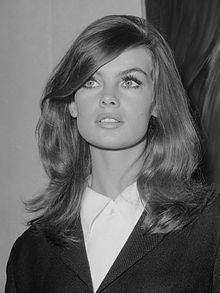
WriterHelen Gurley BrownwroteSex and the Single Girlin 1962. This book acted as a guide for women of any marital status to take control of their own lives financially as well as emotionally.[55]This book was revolutionary since it encouraged sex before marriage; something that was historically looked down upon. With the high success of this book, a pathway was set for media to also encourage this behavior.Betty Friedanalso wroteThe Feminine Mystiquethe following year, giving insight into the suburban female experience, further igniting women's push for a more independent lifestyle.[56]Thesecond-wave of feminismwas getting its start during this period: pushing for a new feminine ideal to be capitalized on.
Fashion photography in the 1960s represented a new feminine ideal for women and young girls: the Single Girl. 1960s photography was in sharp contrast to the models of the 1920s, who were carefully posed for the camera and portrayed as immobile. The Single Girl represented 'movement'. She was young, single, active, and economically self-sufficient. To represent this new Single Girl feminine ideal, many 1960s photographers photographed models outside—often having them walk or run in fashion shoots. Models in the 1960s also promoted sports wear, which reflected the modern fascination with speed and the quickening pace of the 1960s urban life. Although the Single Girl was economically, socially and emotionally self-sufficient, the ideal body form was difficult for many to achieve. Therefore, women were constrained by diet restrictions that seemed to contradict the image of the empowered 1960s Single Girl.[57]
Fashion photographers also photographed the Single Girl wearing business wear, calling her the Working Girl. The Working Girl motif represented another shift for the modern, fashionable woman. Unlike earlier periods, characterized by formal evening gowns and the European look, the 1960s Working Girl popularized day wear and "working clothing". New ready to wear lines replaced individualized formal couture fashion. The Working Girl created an image of a new, independent woman who has control over her body.[57]
There was a new emphasis onready-to-wearand personal style. As the 1960s was an era of exponential innovation, there was appreciation for something new rather than that of quality.[22]Spending a lot of money on an expensive, designer wardrobe was no longer the ideal and women from various statuses would be found shopping in the same stores.
The Single Girl was the true depiction of the societal and commercial obsession with the adolescent look.[22]Particular to the mid-sixties, icons such asTwiggypopularized the shapeless shift dresses emphasizing an image of innocence as they did not fit to any contours of the human body. The female body has forever been a sign of culturally constructed ideals.[58]The long-limbed and pre-pubescent style of the time depicts how women were able to be more independent, yet paradoxically, also were put into a box of conceived ideals.
Dolly Girl[edit]
The "Dolly Girl" was another archetype for young females in the 1960s. She emerged in the mid-1960s, and her defining characteristic is the iconic miniskirt. "Dolly Girls" also sported long hair, slightly teased, and childish-looking clothing. Clothes were worn tight fitting, sometimes even purchased from a children's section. Dresses were often embellished with lace, ribbons, and other frills; the look was topped off with light colored tights. Crocheted clothing also took off within this specific style.[59]
Corsets, seamed tights, and skirts covering the knees were no longer fashionable. The idea of buying urbanized clothing that could be worn with separate pieces was intriguing to women of this era. In the past, one would only buy specific outfits for certain occasions.[60]
Late 1960s (1967–1969)[edit]
The hippie subculture[edit]
Starting in 1967, youth culture began to change musically and Mod culture shifted to a more laid backhippieorBohemianstyle. Hosiery manufacturers of the time like Mary Quant (who founded Pamela Mann Legwear) combined the "Flower Power" style of dress and thePop Artschool of design to create fashion tights that would appeal to a female audience that enjoyedpsychedelia.[61] Ponchos, moccasins, love beads, peace signs, medallion necklaces, chain belts, polka dot-printed fabrics, and long, puffed "bubble" sleeves were popular fashions in the late 1960s. Both men and women wore frayed bell-bottomed jeans, tie-dyed shirts, work shirts, Jesus sandals, and headbands. Women would often go barefoot and some went braless. The idea of multiculturalism also became very popular; a lot of style inspiration was drawn from traditional clothing in Nepal, India, Bali, Morocco and African countries. Because inspiration was being drawn from all over the world, there was increasing separation of style; clothing pieces often had similar elements and created similar silhouettes, but there was no real "uniform".[62]
Fringed buck-skin vests, flowing caftans, the "lounging" or "hostess" pajamas were also popular. "Hostess" pajamas consisted of a tunic top over floor-length culottes, usually made of polyester or chiffon. Long maxi coats, often belted and lined in sheepskin, appeared at the close of the decade.Animal printswere popular for women in the autumn and winter of 1969. Women's shirts often had transparent sleeves. Psychedelic prints, hemp and the look of "Woodstock"emerged during this era.[citation needed]
Indian fashion[edit]

In general, urban Indian men imitated Western fashions such as thebusiness suit.This was adapted to India's hot tropical climate as theNehru suit,a garment often made fromkhadithat typically had amandarin collarand patch pockets. From the early 1950s until the mid-1960s, most Indian women maintained traditional dress such as thegagra choli,sari,andchuridar.At the same time as the hippies of the late 1960s were imitating Indian fashions, however, some fashion conscious Indian andCeylonesewomen began to incorporate modernist Western trends.[63]One particularly infamous fad combined theminiskirtwith the traditionalsari,prompting amoral panicwhere conservatives denounced the so-called "hipster sari"[64]as indecent.
Feminist influences[edit]
During the late 1960s, there was abacklashby radical feminists in America against accouterments of what they perceived to be enforcedfemininitywithin the fashion industry. Instead, these activists wore androgynous and masculine clothing such as jeans, work boots orberets.Black feminists often woreafrosin reaction to thehair straightenersassociated with middle class white women. At the 1968 feministMiss America protest,protestors symbolically threw a number of feminine fashion-related products into a "Freedom Trash Can," including false eyelashes, high-heeled shoes, curlers, hairspray, makeup,girdles,corsets,and bras[65]which they termed "instruments of female torture".[66]
Men's fashion[edit]
Early 1960s (1960–1962)[edit]
Business wear[edit]
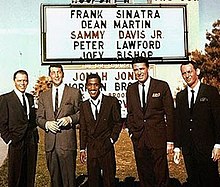
During the early 1960s, slim fitting single breasted continental style suits and skinny ties were fashionable in the UK and America. These suits, as worn bySean ConneryasJames Bond,theRat Pack'sFrank Sinatra,[67]and the cast ofMad Men,were often made from grey flannel,mohairorsharkskin.[68]Tuxedoswere cut in a similar form fitting style, withshawl collarsand a single button, and were available either in the traditional black, or in bright colors such as red or sky blue popularized byFrankie ValliofThe Four Seasons.Men's hats, including thepork pie hatandIrish hat,had narrower brims than thehomburgsandfedorasworn in the 1950s and earlier. During the mid-1960s, hats began to decline[69]after presidentsJohn F. KennedyandLyndon B. Johnsonappeared in public without one.[70]
Ivy League[edit]

Ivy League fashion,the precursor to the modernpreppylook, was desirable casual wear for middle class adults in America during the early to mid 1960s. Typical outfits includedpolo shirts,harrington jackets,khakichino pants,striped T-shirts,Argyle socks,seersuckerorhoundstoothsportcoats,sweater vests,cardigan sweaters,Nantucket Reds,basketweave loafers, Madras plaid shirts, and narrow brimmedTrilbyssometimes made from straw.[71][72]The style remained fashionable for men until it was supplanted by more casual everyday clothing influenced by thehippiecountercultureduring the late 1960s andearly 1970s.[73]
Mid 1960s (1963–1966)[edit]
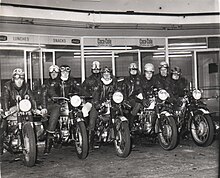
Surf fashion[edit]

In America and Australia,surf rockwent mainstream from 1962 to 1966, resulting in many teenagebaby boomersimitating the outfits of groups likeThe Beach Boys.Pendleton jacketswere common due to their cheapness, warmth and durability. Design wise the surf jacket suited popularly with nonchalance, warmth for coastal Californian climate, and utility pockets for surf wax and VW car keys, two surf essentials (Pendleton Woolen Mills).[74]
The Pendleton Surf Jacket expanded upon Fifties pop-cultural fashions, however new in its relaxed, intangibly cool vibe. The surf jacket split from the tough guy rock 'n' roll teen, and mellowing leather's rock attitudes to woolen plaids. FollowingRock n Roll's decline were rebels without causes, "Greasers"and" Beats "; dressed down in inappropriate daywear to denounce conformity, Sixties youth, inventors of Surf Fashion, expressed more nomadic and hedonically in this" dress down "style. Surf styles mainstreamed into fashion whenSoul Surferswanted to make livings in surfing-associated careers. They opened businesses that expanded selling surf products into selling surf clothing. These surfer entrepreneurs proliferate surf fashion by mixing their lifestyles into casual wear.[75]As Rock n Roll Beats, and Greaser car clubs used jackets to identify, and as 1950 varsity sports wore lettered cardigans, 1960sSurfieswore surf jackets to identify with surf clubs and as surfers (Retro 1960s Swimwear).[76]Jackets worn as group status identifiers continued in the Sixties, but with focus around beach music and lifestyle.
As surfers banded overlocalism,plaid and striped surf jackets gained relevancy. Teens wore them to proclaim surf clubs; what beach they were from, and where they surfed. For a surfer though, it is curious why a woolen plaid jacket paired withUGG boots,and not theboard-shortoraloha shirtidentified the surfer. The Pendletonplaid,originally worn byloggers,hunters and fishermen, was a common item ofcasual wearfor American men of all classes before theBritish invasion.For the youth of the 1960s, however, the plaid Pendleton signifiedcounterculture,and tribal seamen style translated from Welsh folklore, rebellious ScotsHighlanders,and rugged American frontiersmen (Bowe).[77]
The Sixties invented the Californian Cool style, by relaxing style to escapeCold Warmeltdowns withPolynesianfascinations, bridging the macho 1950s teen towards 1960s Hippie style. The Cold War's tense political context conceived Surf Fashion as a way to relax and escape established violence. California, the birthplace of American Surfing, also produced much of the technology experimentations used in the nuclear space race.Caltechdesigners in Pasadena were designing nuclear arms for day jobs and were surfing at night. The modern surfboard design itself originates from the military-industrial complex's product development, where the Manhattan Project'sHugh Bradneralso designed the modern neoprenewetsuit(Inside the Curl).[78]
Californian engineers for the Cold War were also surfing and equally engineering that fashion. Just as theBikini's name comes from a nuclear test site, Surf fashion in this era consistently references the Cold War context. Surfing became an attractive fashion identity in this era because it perpetuates adolescence, and the pursuit of pleasure in times of anxiety and paranoia. In a teenage-driven culture, which aimed to ignore establishment conflicts, surfers musedHawaiiand its associatedtiki cultureas a place of escape with tropical paradises as the antithesis to modern society. This sustained Hawaiian flora and fauna patterns' in fashion its attraction. The Sixties Surfer was not the first to escape violence or revolutionize the pursuit of happiness through Polynesian fascination. Accounts ofThomas Jeffersontheorize that his exposure to the surfer image in South Pacific travel journals influenced his imaginedPursuit of Happiness(Martin D. Henry).[79]Similarly, Hawaii's surfer image and Californian translation responds to the decade's violence and further inspired full-on nonviolent revolutionary Hippie fashions.
Additionally, as Californian water inspired lifestyles influenced fashion, many guys improvised their ownfaded jeansusingchlorinefrom backyard swimming pools.[80]Sneakers such asConverse All Starsmade the transition fromsportswearto streetwear, and guys in California and Hawaii began togrow out their hair.[81]
Mod and British Invasion influences[edit]

The leaders of mid-1960s style were the British. The Mods (short for Modernists) adopted new fads that would be imitated by many young people. Mods formed their own way of life creating television shows and magazines that focused directly on the lifestyles of Mods.[1]British rock bands such asThe Who,The Small Faces,the Beatles,andThe Kinksemerged from the Mod subculture. It was not until 1964, when the Modernists were truly recognized by the public, that women really were accepted in the group. Women had short, clean haircuts and often dressed in similar styles to the male Mods.[4]
The Mods' lifestyle and musical tastes were the exact opposite of their rival group, known as theRockers.The rockers liked 1950s rock-and roll, wore black leather jackets, greased,pompadourhairstyles, and rode motorbikes. The look of the Mods was classy. They mimicked the clothing and hairstyles of high fashion designers in France and Italy, opting for tailored suits that were topped by parkas. They rode on scooters, usuallyVespasorLambrettas.Mod fashion was often described as the City Gent look. The young men[82]incorporated striped boating blazers and bold prints into their wardrobe.[83]Shirts were slim, with a necessary button down collar accompanied by slim fitted trousers.[4]Levi'swere the only type of jeans worn by Modernists.
In the USSR during the mid to late 1960s, Mods and Hippies were nicknamed Hairies for theirmop tophair.[84]As with the earlierStilyagiin the 1950s, young Russian men who dressed this way were ridiculed in the media, and sometimes forced to get their hair cut in police stations.[85]
Late 1960s (1967–1969)[edit]
Folk and counterculture influences[edit]

The late 1960s to early 1970s witnessed the emergence of thehippiecountercultureandfreak scenein Britain, Australia, New Zealand and America. Middle class youths of both sexes favored a unisex look with long hair,tie dyeandflower powermotifs,Bob Dylan caps,kurtas,hemp waistcoats,baja jackets,bell bottoms,sheepskinvests,western shirtsandponchosinspired byacid Westerns,sandals,digger hats,and patches featuring flowers orpeace symbols.[86]Jimi Hendrixpopularized the wearing of old militarydress uniformsas a statement that war was obsolete.[87]Early hippies, derisively referred to as freaks by the older generation, also used elements of roleplay such as headbands, cloaks,frock coats,kaftans,corduroypants,cowboy boots,andvintage clothingfromcharity shops,suggesting a romantic historical era, a distant region, or a gathering of characters from afantasyorscience fictionnovel.[88]
Peacock Revolution[edit]

By 1968, the space age mod fashions had been gradually replaced byVictorian,EdwardianandBelle Époqueinfluenced style, with men wearing double-breasted suits ofcrushed velvetor striped patterns, brocade waistcoats and shirts with frilled collars. Their hair worn below the collar bone. Rolling Stones guitaristBrian Jonesepitomised this "dandified" look. Due to the colorful nature of menswear, the time period was described as thePeacock Revolution,and maletrendsettersin Britain and America were called "Dandies," "Dudes,"or" Peacocks. "[89]From the late 1960s until the mid-1970sCarnaby StreetandChelsea'sKings Roadwere virtual fashion parades, as mainstream menswear took onpsychedelicinfluences. Business suits were replaced by BohemianCarnaby Streetcreations that includedcorduroy,velvet or brocade double breasted suits,frilly shirts,cravats, wide ties and trouser straps, leather boots, and even collarlessNehru jackets.The slimnecktiesof the early 1960s were replaced withKipper tiesexceeding five inches in width, and featuring crazy prints, stripes and patterns.[90]
Hairstyles of the 1960s[edit]
Women's hairstyles[edit]

Women's hair styles ranged frombeehive hairdosin the early part of the decade to the very short styles popularized byTwiggyand Mia Farrow just five years later to a very long straight style as popularized by the hippies in the late 1960s. Between these extremes, the chin-length contour cut and thepageboywere also popular. Thepillbox hatwas fashionable, due almost entirely to the influence ofJacqueline Kennedy,who was a style-setter throughout the decade. Her bouffant hairstyle, described as a "grown-up exaggeration of little girls' hair", was created byKenneth.[91][92]
During the mid and late 1960s, women's hair styles becamevery bigand used a large quantity of hair spray, as worn in real life byRonnie Spectorand parodied in the musicalHairspray.Wigs became fashionable and were often worn to add style and height. The most important change in hairstyles at this time was that men and women woreandrogynousstyles that resembled each other. In the UK, it was the new fashion for mod women to cut their hair short and close to their heads.[93]Meanwhile, hippie girls favored long, straight natural hair, kept in place with abandana.
Men's hairstyles[edit]

For professional men born before 1940, the side partedshort back and sideswas the norm in the UK, Europe and America from the early 60s until the end of the decade. Black men usually buzzed their hair short or wore styles like theconk,artificially straightened with chemicals. Blue collar white men, especially former military personnel, often worebuzzcutsandflat tops.During the early to mid 60s, rebelliousIrish-American,Italian-AmericanandHispanicteens influenced by thegreaser subcultureoften woreducktails,pompadoursandquiffs.[citation needed]
Due to the influence ofmodbands likethe Beatlesor theRolling Stones,mop-tophairstyles were most popular for white andHispanicmen during the mid 60s.[citation needed]Themod haircutbegan as a short version around 1963 through 1964, developed into a longer style worn during 1965–66, and eventually evolved into an unkempt hippie version worn during the 1967–1969 period and into the early 1970s. Facial hair, evolving in its extremity from simply having longer sideburns, tomustachesand goatees, to full-grown beards became popular with young men from 1966 onwards.
Head coverings changed dramatically towards the end of the decade as men's hats went out of style, replaced by thebandanna,digger hat,Stetson,orBob Dylan capif anything at all. As men let their hair grow long, theAfrobecame the hairstyle of choice forAfrican Americans.[citation needed]This afro was not just a fashion statement but also an emblem of racial pride. They started to believe that by allowing their hair to grow in its nature state without chemical treatments, they would be accepting their racial identities.[94]
Image gallery[edit]
A selection of images representing the fashion trends of the 1960s:
-
First LadyJacqueline Kennedywearing a red wool dress with matching jacket. She was a fashion icon in the early 1960s.
-
Singer and actressBarbra Streisandin 1962 wearing a top with a crew-neck. Her hair is teased at the crown.
-
Graciela Borges,Argentine fashion icon of the 1960s, wearing a fur coat,bouffanthair and wingedeye liner.
-
In 1965, sleevelessshift dresseswere popular with women.
-
Young woman inFlorida,1965.
-
A velvet minidress from 1965.
-
American girl wearing a mini skirt and patternedtights,1966.
-
Philippine first ladyImelda Marcoswith U.S. PresidentLyndon B. Johnsonwhile sporting her iconic beehive hairstyle, 1966.
-
Young woman wears her hair in a headband with flipped ends, 1967.
-
Woman at aSingaporezoo, 1967. Note her Pucci-style print dress.
-
Dress byPaco Rabanne,1967
-
East German politicians wearinghorn rimmed glasses,cat eye glasses,andwire rimmed glasses,late 1960s.
-
Argentine actressNacha Guevarac. 1968.
-
In the late 1960s, brides often wore white mini wedding dresses.
-
Two men at theWoodstock Festival,1969
-
Boy with amop tophair cut, 1969.
-
SingerMaria Muldaurin 1968, wearing a gypsy-stylekerchiefand hoop earrings.
See also[edit]
Fashion designers[edit]
Style icons[edit]
- Marella Agnelli
- Anouk Aimée
- Brigitte Bardot
- Jane Birkin
- Amanda Burden
- Pattie Boyd
- Claudia Cardinale
- Cher
- Consuelo Crespi
- Julie Christie
- Catherine Deneuve
- Farah Diba
- Faye Dunaway
- Jane Fonda
- Dolores Guinness
- Gloria Guinness
- Audrey Hepburn
- Jacqueline Kennedy
- Sophia Loren
- Babe Paley
- Hope Portocarrero
- Lee Radziwill
- Vanessa Redgrave
- Jacqueline de Ribes
- Diana Ross
- Diana Rigg
- Edie Sedgwick
- Nancy Sinatra
- Queen Sirikit
- Sharon Tate
- Raquel Welch
- Steve Winwood
- Natalie Wood
- Stevie Wright
- Jayne Wrightsman
- Harry Vanda
- Gloria Vanderbilt
Supermodels[edit]

Fashion photographers[edit]
Teenage subcultures[edit]
- Greaser subculture
- Mod subculture
- Soc subculture
- Youthquake
- Surfer
- Beatnik
- Hippie
- Rude Boy
- Skinhead
- Black Panthers
Other[edit]
References[edit]
- ^ab"Braggs, Steve, and Diane Harris. 60s Mods".Retrowow.co.uk. March 1, 2009.
- ^Rich Candace (2010–2015)."Makeup".Fiftiesweb.com.
- ^Vidcat1 (February 13, 2007)."Vintage Fashion Newsreels 1960s".Youtube.com. Archived fromthe originalon 2010-05-07.RetrievedMarch 27,2009.
- ^abcd"Braggs, Steve, and Diane Harris. 60s Mods".Retrowow.co.uk. March 1, 2009.
- ^"Goodwin, Susan, and Becky Bradley. American Cultural History: 1960–1969".Kingwood College Library. March 1, 2009. Archived fromthe originalon March 1, 2009.
- ^"Audrey Hepburn's style hits".Harper's BAZAAR.2014-05-02.Retrieved2016-02-08.
- ^1962 Sears catalog
- ^Deslandres, Yvonne (1987). Boucher, François (ed.).20,000 Years of Fashion: the history of costume and personal adornment(Expanded ed.). New York: Harry N. Abrams.ISBN0-8109-1693-2.
- ^Gibson, Megan (5 July 2011)."Top 10 Bikinis in Pop Culture".Time.Retrieved17 June2018.
- ^"The bikini celebrates 60 years".22 July 2006. Archived fromthe originalon 2008-07-06.
- ^"Monokini".Archivedfrom the original on 18 August 2015.Retrieved20 August2015.
- ^"Bikini Science".Archivedfrom the original on 2018-01-27.Retrieved2018-01-27.
- ^"Monokini".Free Dictionary.Retrieved20 August2015.
- ^Rosebush, Judson."Peggy Moffitt Topless Maillot in Studio".Bikini Science.Archived fromthe originalon 27 January 2018.Retrieved27 January2018.
- ^abAlac, Patrik (2012).Bikini Story.Parkstone International. p. 68.ISBN978-1780429519.Archivedfrom the original on 2018-01-29.
- ^"Bikini Styles: Monokini".Everything Bikini. 2005. Archived fromthe originalon 29 July 2012.Retrieved13 January2013.
- ^Nangle, Eleanore (June 10, 1964)."Topless Swimsuit Causes Commotion".Chicago Tribune.Archivedfrom the original on 14 September 2015.Retrieved20 August2015.
- ^"Fit Celebrates the Substance of Style".Elle.July 5, 2009.Archivedfrom the original on 24 September 2015.Retrieved23 August2015.
- ^Parnis, Mollie. "Fashion and Dress".1959 Britannica Book of the Year: Events of 1958.Encyclopaedia Britannica, Inc. p. 247.
In 1958, the 'revolutionary' silhouette was a long, unbroken oval, obviously inspired by a space rocket's shape...
- ^Fogarty, Anne. "Fashion".The Americana Annual 1959: Events of 1958.Americana Corporation. p. 250.
The chemise...began in Paris in 1957,...variously called the sack, the shift, or the space silhouette...
- ^abPavitt, Jane (2008).Fear and fashion in the Cold War.London: V&A Pub. p. 60.ISBN9781851775446.
- ^abcWalford, Johnathan (2013).Sixties fashion: From less is more to youthquake.London: Thames & Hudson. p. 110.ISBN9780500516935.
- ^Pierre Cardin
- ^Blackwell, Betsy Talbot. "Fashions".The American Peoples Encyclopedia 1966 Encyclopedia Yearbook: Events of 1965.Grolier Incorporated. p. 233.
...she chose...a silver-mesh sweater to pour over silver bell-bottoms. And she would have no trouble finding silver-flecked stockings and silver-kid sandals.
- ^Howell, Georgina (1978). "1966".In Vogue: Sixty Years of Celebrities and Fashion from British Vogue.Harmondsworth, Middlesex, England: Penguin Books Ltd. p. 292.ISBN0-14-00-4955-X.
...everything silver, from visor to stockings and shoes...[Y]ou wear silver leather and plastic chain mail...chrome jewellery,...silver stockings, silver shoes laced up the leg, bangles of clear plastic and chrome. Silver leather or shirred silver nylon make the new jackets...
- ^Blackwell, Betsy Talbot. "Fashions".The American Peoples Encyclopedia 1966 Encyclopedia Yearbook: Events of 1965.Grolier Incorporated. p. 232.
Op art was a natural for fabric design, and many a 1965 shift was opped-up.
- ^Cassini, Oleg. "Fashion".Collier's 1966 Year Book: Covering the Year 1965.Crowell Collier and MacMillan, Inc. p. 212.
Op Art, the newest in the art world, was quickly incorporated into clothes and makeup....James Galanos fashioned two Op-inspired fabrics...into this dazzling dress, which seems to be part of its background, Op artist Victor Vasarely's kaleidoscopic collage.
- ^Emerson, Gloria(1966-01-27)."Paris: Strictly for Small-Boned Girls".The New York Times:37.Retrieved2023-07-13.
Roger Vivier, who provides most of the new shoes for the haute couture, has made everything in clear plastic this year...
- ^Hasson, Rachelle. "Fashion".World Book Year Book 1968: Events of 1967.Chicago, Illinois, USA: Field Enterprises Educational Corporation. pp. 336, 338.
Women...fancied high boots as a means of covering their new length of leg. High-rise stretch vinyl or patent leather provided glovelike sleekness...Boots stretched to the knees, to the thighs, or even to cover the entire leg like [a] fisherman's hip boots....Autumn gave new luster to shoes and handbags of patent leather...
- ^Yotka, Steff (8 January 2016)."Remembering André Courrèges".Vogue.Retrieved2016-05-19.
- ^BBC Culture: Space age fashion
- ^"Fashion for the '70s: Rudi Gernreich Makes Some Modest Proposals".Life.Vol. 68, no. 1. 1970-01-09. pp. 115–118.Retrieved2022-01-03.
- ^"Jean-Marie Armand".Couture Allure.2011-03-08.Retrieved2021-12-13.
His designs were very modern and architectural, much like those of Courreges and Cardin.
- ^Howell, Georgina (1978). "1963".In Vogue: Sixty Years of Celebrities and Fashion from British Vogue.Harmondsworth, Middlesex, England: Penguin Books Ltd. pp. 280, 283.ISBN0-14-00-4955-X.
Saint Laurent's black and white geometric shifts...Saint Laurent: Black ciré smock[, helmet,] and thigh-high alligator boots.
- ^Peake, Andy (2018). "Chapeau Melon et Bottes de Cuir".Made for Walking.Atglen, Pennsylvania: Schiffer Fashion Press. p. 57.ISBN978-0-7643-5499-1.
Yves Saint Laurent's fall...1963...visored caps, black leather jerkins, and Roger Vivier's...thigh-high...boots in crocodile gave what [theDaily Mail's Iris] Ashley called 'a real space girl effect...'
- ^"1965 Homage to Piet Mondrian".Musée Yves Saint Laurent Paris.Retrieved2022-01-09.
- ^Howell, Georgina (1978). "1966".In Vogue: Sixty Years of Celebrities and Fashion from British Vogue.Harmondsworth, Middlesex, England: Penguin Books Ltd. p. 292.ISBN0-14-00-4955-X.
Saint Laurent makes his shifts...transparent except where they are striped or chevroned with silver sequins.
- ^Howell, Georgina (1978). "1966".In Vogue: Sixty Years of Celebrities and Fashion from British Vogue.Harmondsworth, Middlesex, England: Penguin Books Ltd. p. 292.ISBN0-14-00-4955-X.
Space projections...plastic, chrome, Dynel...[Y]ou wear...skirts that show the whole length of your legs, mops of artificial hair coloured pink, green and purple...and visor sunglasses....huge plastic disc earrings,...and eye make-up is designed to be seen from 100 yards, in streamlined eyeliners, black and white used alternately...
- ^Howell, Georgina (1978). "1967-68".In Vogue: Sixty Years of Celebrities and Fashion from British Vogue.Harmondsworth, Middlesex, England: Penguin Books Ltd. p. 296.ISBN0-14-00-4955-X.
1967-68...mark[ed] the change in direction from futurist to romantic fashion....[i]n reaction to the uniformity of geometric haircuts and 'functional' fashion, stiff carved tweed shifts and creaking plastic...
- ^ab"Pierre Cardin".Encyclopædia Britannica.2016.Retrieved2016-05-18.
- ^Owoseje, Toyin; Siad, Amaud (3 February 2023)."Paco Rabanne, Spanish fashion designer known for his Space Age creations, dies at 88".CNN.Retrieved3 February2023.
- ^Kennedy, Alicia (2013).Fashion design, referenced: A visual guide to the history, language, and practice of fashion. Gloucester.MA: Rockport.ISBN978-1592536771.
- ^Leung, Yasmine (3 February 2023)."Who Owns Paco Rabanne Now? Visionary Designer Dies Aged 88".HITC.Retrieved3 February2023.
- ^Goodfellow, Melanie (3 February 2023)."Paco Rabanne Dies: Spanish 'Barbarella' Fashion Designer Was 88".Deadline Hollywood.Retrieved3 February2023.
- ^Philips, Hedy (3 February 2023)."Spanish Fashion Designer Paco Rabanne Dies at Age 88".People.com.Retrieved3 February2023.
- ^Parks, C. (2015, March 23).The Miniskirt: An Evolution From The '60s To Now.Retrieved October 30, 2016, fromhttp://www.huffingtonpost.com/2015/03/23/mini-skirt-evolution_n_6894040.html
- ^Paula Reed. (2012). InFifty Fashion Looks that Changed the 1960s(pp. 30–31). England: Alison Starling.
- ^Koda, H. (2010).100 Dresses: The Costume Institute,The Metropolitan Museum of Art. S.l.: Yale University Press.
- ^Blackman, C. (2012).100 Years of Fashion.London: Laurence King Pub.
- ^Nectara, J (2012, July 13). "The Miniskirt – A Short History." Retrieved October 30, 2016, from[1]
- ^Bourne, L. (2014). "A history of the Miniskirt: How fashion's most daring hemline came to be." Retrieved October 30, 2016, fromhttp://stylecaster.com/history-of-the-miniskirt/
- ^Niara. (2016, January 9). "Aesthetics and Activism: The history of miniskirt." Retrieved October 30, 2016, fromhttp://www.collegefashion.net/inspiration/the-history-of-the-miniskirt/
- ^Tarrant, Naomi (1994).The Development of Costume.London: Routledge. p. 88.
- ^Contini, p. 317
- ^Brown, Helen Gurley (1962).Sex and the Single Girl.Bernard Geis Associates.ISBN9781569802526.
- ^Friedan, Betty (1963).The Feminine Mystique.W. W. Norton and Co.ISBN0-393-32257-2.
- ^abRadner, Hilary (2001). "Embodying the Single Girl in the 1960s". In Joanne Entwistle and Elizabeth B. Wilson (ed.).Body Dressing.Bloomsbury Academic. pp. 183–197.ISBN1859734448.
- ^Evans, C. (1991). "Fashion, Representation, Femininity".Feminist Review.38:48–66.doi:10.1057/fr.1991.19.S2CID143932525.
- ^Bond, David (1981).The Guinness Guide to 20th Century Fashion.Middlesex: Guinness Superlatives Limited. pp. 164, 176.ISBN0851122345
- ^Belinda T. Orzada (2000-01-10)."Orzada, Belinda T." Fashion Trends and Cultural Influences 1960-present. "Twentieth Century Design: Ethnic Influences. 7 Oct. 1998. University of Delaware. 10 Apr. 2009".Udel.edu. Archived fromthe originalon 2012-06-18.Retrieved2012-08-11.
- ^ Hosiery Trends Over The Decades
- ^Miles, Barry (2004).Hippie.Sterling.ISBN1402714424.
- ^"Reading Eagle - Google News Archive Search".news.google.com.
- ^"Gadsden Times - Google News Archive Search".news.google.com.
- ^Dow, Bonnie J. (Spring 2003). "Feminism, Miss America, and Media Mythology".Rhetoric & Public Affairs.6(1): 127–149.doi:10.1353/rap.2003.0028.S2CID143094250.
- ^Duffett, Judith (October 1968).WLM vs. Miss America.Voice of the Women's Liberation Movement. p. 4.
- ^"A guide to Suit Problems for men".11 December 2012. Archived fromthe originalon February 14, 2013.
- ^"Mohair Suiting Fabric Guide—Gentleman's Gazette".www.gentlemansgazette.com.28 November 2015.
- ^"The History And Abuse of The Fedora".Archived fromthe originalon 2017-05-14.Retrieved2017-11-25.
- ^"Top Hats and Bibles: Inauguration Traditions".ABC News.19 January 2009.
- ^"League of gentlemen: How to get the effortlessly cool style of Paul".Independent.co.uk.2010-09-19.Archivedfrom the original on 2022-05-01.
- ^"Claudio De Rossi talks Ivy with Jimmy Frost Mellor - Modculture".26 October 2017.
- ^"The Ivy Style Primer—Gentleman's Gazette".www.gentlemansgazette.com.13 July 2018.
- ^"Pendleton Woolen Mills - An Unlikely Surf Icon".Heddels. 2016-09-12.Retrieved2018-04-15.
- ^Jones, Glynis (2010). "Subcultural and Alternative Dress in Australia".Australia, New Zealand, and the Pacific Islands.Vol. 7. pp. 216–223.doi:10.2752/bewdf/edch7034.ISBN9781847888563.
- ^"Retro 1960s Swimwear, Beachwear and Surf Fashion".Dust Factory Vintage Clothing Wholesale. 2016-06-26.Retrieved2018-04-15.
- ^"The History of Flannel - Gear Patrol".Gear Patrol. 2014-10-02.Retrieved2018-04-15.
- ^"Inside the Curl: Surfing's Surprising History".2013-08-04. Archived fromthe originalon August 6, 2013.Retrieved2018-04-15.
- ^Martin D. Henry (ITQ, vol. 63/3, 1998, 250–62)
- ^Stebbins, Jon (1 September 2011).The Beach Boys FAQ: All That's Left to Know About America's Band.Backbeat Books.ISBN9781458429148– via Google Books.
- ^Zhito, Lee (29 June 1963)."Surfing Craze Ready to Splash Across Country to East's Youth".Billboard.Nielsen Business Media, Inc. p. 26 – via Google Books.
- ^Pendergast, Tom and Sarah (2004).Fashion, Costume and Culture.MI, USA: Thomson Gale. p.895.ISBN0-7876-5422-1.
- ^"For Your Love: The Best of the Sixties British Invasion".Rolling Stone.2014-06-02.Retrieved2016-02-08.
- ^Jackson, Andrew Grant (3 February 2015).1965: The Most Revolutionary Year in Music.Macmillan.ISBN9781466864979– via Google Books.
- ^Safanov, Mikhail (8 August 2003)."Confessions of a Soviet moptop".The Guardian.
- ^"Photos of hippies".Archived fromthe originalon 2016-07-03.Retrieved2017-11-27.
- ^"Troubled Times: 1961–79 – Fashion, Costume, and Culture: Clothing, Headwear, Body Decorations, and Footwear through the Ages".www.fashionencyclopedia.com.Retrieved2017-10-07.
- ^"Bell-Bottoms facts, information, pictures | Encyclopedia.com articles about Bell-Bottoms".www.encyclopedia.com.Retrieved2017-10-07.
- ^"The Peacock Revolution".The Peacock Revolution and the Beatles: British Men's Fashion from 1963–1973.Retrieved2017-10-07.
- ^Marshall, Peter (February 27, 2009)."Peacock Revolution: Informal Counterculture".Black-tie-guide 2009. Archived fromthe originalon 2016-10-19.
- ^Collins, Amy Fine (1 June 2003)."It had to be Kenneth.(hairstylist Kenneth Battelle)(Interview)".Vanity Fair.Retrieved3 December2012.
- ^Wong, Aliza Z. (2010). Julie Willett (ed.).The American beauty industry encyclopedia: Hairstylists, Celebrity.Santa Barbara, Calif.: Greenwood. pp. 151–154.ISBN9780313359491.
- ^Pendergast, Tom and Sarah (2004).Fashion, Costume and Culture.MI, USA: Thomson Gale. p.935.ISBN0-7876-5422-1.
- ^Pendergast, Tom and Sarah (2004).Fashion, Costume and Culture.MI, USA: Thomson Gale. pp.937–938.ISBN0-7876-5422-1.
External links[edit]
- "Collection highlights".Fashion, Jewellery & Accessories.1960s Fashion and Textiles collection.Victoria and Albert Museum.Retrieved2007-06-08.
- "60s Fashion in the Round".Fashion, Jewellery & Accessories.Victoria and Albert Museum.Archived fromthe originalon 2007-11-26.Retrieved2007-12-09.
- "1960s - 20th Century Fashion Drawing and Illustration".Fashion, Jewellery & Accessories.Victoria and Albert Museum.Archived fromthe originalon 2011-07-14.Retrieved2011-04-03.
- "Swing Fashion – Coats and Jackets".Swing Fashion.Fashion Ode. Archived fromthe originalon 2014-12-23.Retrieved2014-12-23.
- Everyday Life in the 1960s-Expired Knowledge







